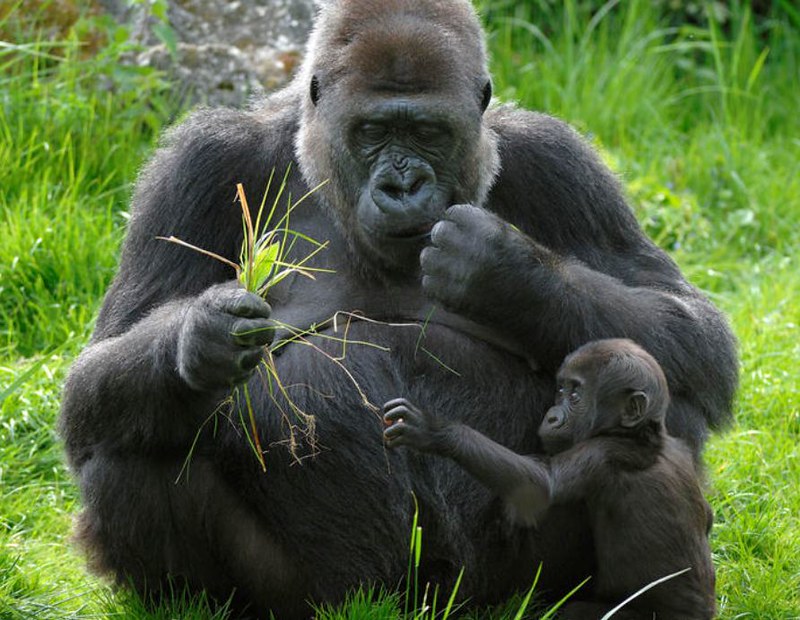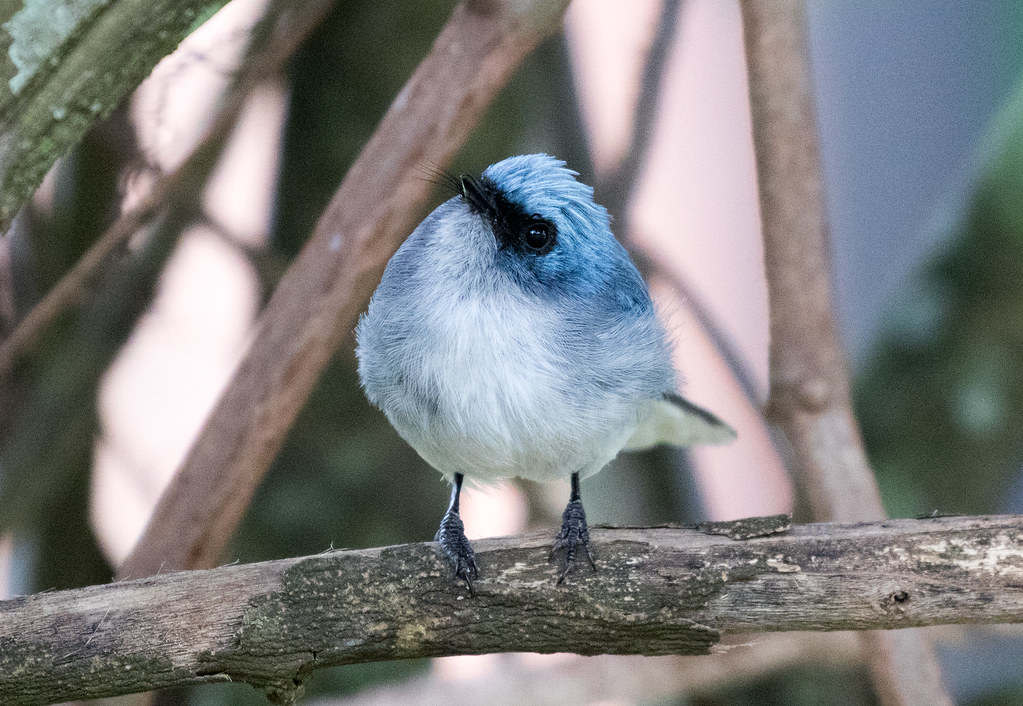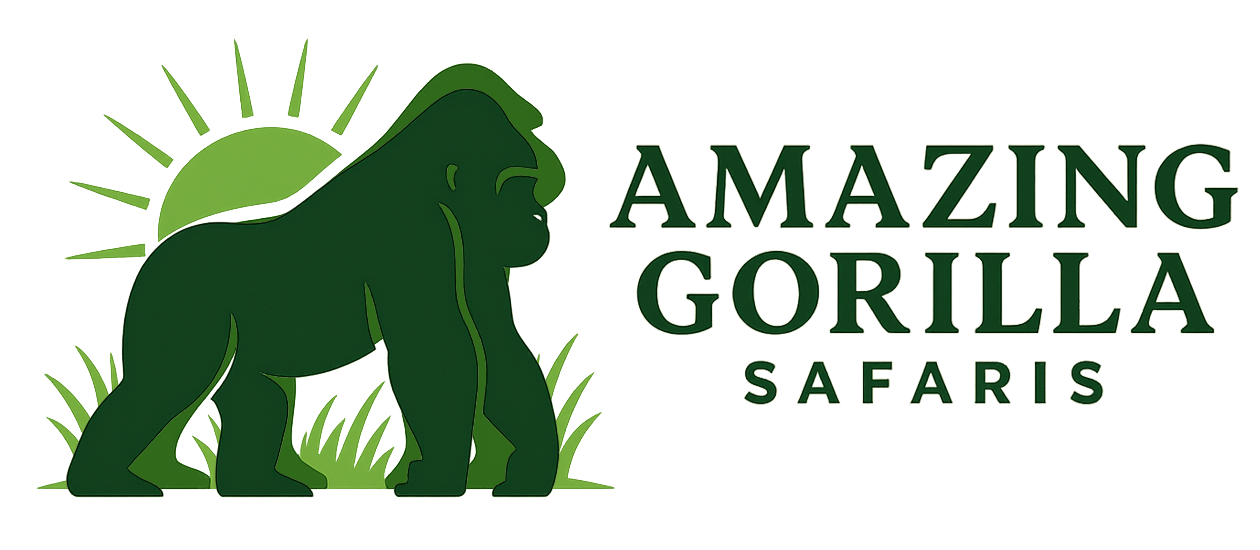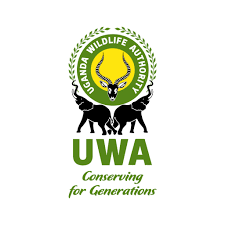Best Rated Gorilla Safari
Our gorilla safaris are praised by travelers for the unforgettable moments
Advice from Gorilla Safari
Choose gorilla safaris for unmatched wildlife encounters and lasting memories.
Exceptional range of lodging options
Exceptional range of lodging options ensures comfort throughout your safari.
Full-Service Vacation Packages
Enjoy seamless travel with comfort, adventure, holiday experiences.
Unforgettable Gorilla Safaris in Uganda & Rwanda
Meet Gorilla Safaris the highlight of African wildlife adventures.
Gorilla safaris are the ultimate wildlife adventure in Africa. They take you deep into the rainforests of Uganda and Rwanda, where you can encounter endangered mountain gorillas in their natural habitat. Unlike typical game drives, these safaris involve trekking through dense jungle with expert guides until you come face to face with a gorilla family. Uganda and Rwanda are the best destinations for gorilla safaris. Bwindi Impenetrable Forest and Mgahinga in Uganda, along with Rwanda’s Volcanoes National Park, offer unforgettable treks where visitors can observe silverbacks, mothers, and playful infants in the wild.
Our Recommended African Primate Tours
3 Days in Bwindi Trekking
This 3 Days in Bwindi Trekking tour takes you deep into the jungles of Uganda for an encounter with mountain gorillas.
1 Day Short Gorilla Trip
While longer safaris allow for more exploration, the 1-day gorilla trip is ideal for travelers with tight schedules.
3 Days Rwanda Gorilla
A 3-day gorilla safari in Rwanda is the perfect way to combine the breathtaking experience of trekking
2 Days Queen Elizabeth National Park
Queen Elizabeth National Park, Uganda’s most popular safari destination, offers landscapes of sweeping savannah
3 Days Ssesse Islands Tour & Water Safaris
Far from the bustling energy of Kampala and the adventure trails of Uganda’s national parks on Ssese Islands
A 5-day safari in Uganda is the perfect balance between encountering the rare mountain gorillas of Bwindi Impenetrable Forest
Know Before You Go Guide
How and where to see gorillas in the wild
Gorilla trekking is a once-in-a-lifetime experience that takes you deep into Africa’s misty forests to observe endangered mountain gorillas in their natural habitat. The best places to see them are Bwindi Impenetrable National Park and Mgahinga (Uganda), Volcanoes National Park (Rwanda), and Virunga National Park (DR Congo).
Plan a Gorilla AdventureA Wildlife Travel Guide
Guide to seeing chimpanzees in the wild
Chimpanzee trekking is a thrilling adventure through Africa’s lush forests to observe our closest relatives in the wild. The best spots include Kibale Forest (Uganda), Mahale & Gombe (Tanzania), and Nyungwe (Rwanda).
Plan a Chimps adventureWildlife Animals In Africa
Types Of Gorillas In Africa
3 Days Tour Murchison Falls National Park
A 3-day safari to Murchison Falls is more than just a quick getaway—it is a concentrated adventure that delivers everything a classic African safari promises.
4 Days Rwanda Gorilla Tour and Golden Monkeys
A 4-day safari in Rwanda offers a perfect blend of gorilla trekking, golden monkey encounters, and a deeper exploration of the country’s landscapes and culture
4 Days Rwanda Gorilla Trekking Safari
This 4 days Rwanda and Uganda safari combines the best of East Africa’s wildlife, landscapes, and cultural experiences. The adventure begins in Rwanda
Frequently Asked Questions About Gorilla Trekking Safari
Know Before You Go "What is the best time to visit for gorilla trekking safari?", "Which countries offer the best safari experiences?", "How do I choose a safari operator?", "What should I pack?", "Are safaris safe?", "What is the cost of a safari?", "Do I need any special permits or vaccinations?", and "Can I customize my safari itinerary?"
Where Can You Go Gorilla Trekking?
Uganda
Uganda is one of the best places for gorilla trekking, hosting more than half of the world’s remaining mountain gorillas. Bwindi Impenetrable National Park, a UNESCO World Heritage Site, is the most famous destination, with several habituated gorilla families available for trekking. It is known for challenging hikes through thick jungle and rewarding encounters with gorillas in their natural environment. Mgahinga Gorilla National Park, smaller but equally rewarding, is located in the Virunga Mountains on the border with Rwanda and the Democratic Republic of Congo. It is home to the Nyakagezi gorilla group.
Rwanda
Rwanda is renowned for its organized and accessible trekking experiences. Volcanoes National Park, part of the Virunga Massif, offers a more luxurious trekking experience with well-developed infrastructure. Trekkers here enjoy stunning views of volcanoes and easier logistics, though permits are more expensive compared to Uganda.
Democratic Republic of Congo (DRC)
The DRC offers a more off-the-beaten-path experience for adventurous travelers. Virunga National Park, Africa’s oldest national park, is home to a significant number of mountain gorillas. Trekking here often feels more rugged and wild compared to Uganda and Rwanda. Kahuzi-Biéga National Park is unique because it offers trekking opportunities for eastern lowland gorillas, a subspecies larger than mountain gorillas.
How Much Does a Gorilla Trekking Permit Cost?
Uganda
A gorilla trekking permit in Uganda costs USD $800 per person per trek. This applies to both Bwindi Impenetrable National Park and Mgahinga Gorilla National Park. Uganda also offers a unique Gorilla Habituation Experience in Bwindi, allowing trekkers to spend up to four hours with a gorilla family. This special permit costs USD $1,500 per person.
Rwanda
Rwanda offers a premium gorilla trekking experience in Volcanoes National Park, with permits priced at USD $1,500 per person per trek. The higher cost is tied to Rwanda’s positioning as a luxury gorilla trekking destination with strong conservation initiatives and world-class tourism services.
Democratic Republic of Congo (DRC)
Gorilla trekking in the DRC is the most affordable. A permit in Virunga National Park costs around USD $400 per person, while trekking eastern lowland gorillas in Kahuzi-Biéga National Park is about USD $400–$450 per person. However, availability may vary depending on regional security and park operations.
How Difficult is Gorilla Trekking?
The Terrain
Mountain gorillas live in dense tropical forests and high-altitude regions. In Uganda’s Bwindi Impenetrable National Park, the terrain is rugged with steep hills, thick undergrowth, and sometimes muddy trails after rain. Rwanda’s Volcanoes National Park is also mountainous, with bamboo forests and volcanic slopes, while Congo’s Virunga and Kahuzi-Biéga National Parks require navigating through rainforest vegetation and sometimes swampy ground. The hikes can last anywhere from 1 to 6 hours or more, depending on where the gorilla family is located that day.
Altitude
Since gorillas live at elevations of 2,200 to 4,000 meters (7,200–13,100 ft), altitude can make trekking more tiring for some visitors. The air is thinner, meaning you may get fatigued faster, especially if you are not used to hiking at high elevations.
Physical Fitness
You don’t need to be an athlete to trek, but a moderate level of fitness is recommended. Trekkers should be comfortable walking long distances on uneven ground, sometimes uphill for extended periods. Porters are available for hire to carry backpacks and provide support on difficult stretches.
Weather Conditions
The forests are humid and rain is common even in the dry season, which makes trails slippery and more challenging. Good hiking boots, waterproof clothing, and walking sticks (often provided by guides) are essential.
Overall Difficulty
Gorilla trekking is considered moderately challenging. Some treks are short and relatively easy if the gorilla family is near, while others can be strenuous if the gorillas are deeper in the forest. However, the pace is usually slow and guides make regular stops, so most reasonably fit travelers—including older adults—successfully complete the trek.
How Long Does a Gorilla Trek Last?
Tracking Time
Mountain gorillas move daily in search of food, so their location changes constantly. Before tourists set out, park rangers track the gorillas at dawn and relay their positions. Some families may be found within an hour’s walk from the trailhead, while others require longer hikes of 4–6 hours through dense forest and steep terrain. In rare cases, treks can stretch close to 7–8 hours if the gorillas are far away.
Time with Gorillas
No matter how long the hike takes, once you reach the gorilla family, you are allowed a maximum of one hour with them. This rule is strictly enforced to minimize stress and human impact on the gorillas. During that hour, you can observe, take photos, and experience their behavior up close.
Overall Duration
Including the briefing at the park headquarters before departure and the return hike, a full gorilla trekking experience usually takes half a day. Most groups are back at their lodges by early afternoon.
What is the Best Time to Go Gorilla Trekking?
Dry Seasons – Peak Trekking Time
The June to September and December to February periods are considered the best times for gorilla trekking in Uganda, Rwanda, and the Democratic Republic of Congo. During these months, rainfall is minimal, making trails less muddy and less slippery. The weather is more predictable, and since vegetation is thinner, spotting gorillas becomes slightly easier. These are also the busiest months, so permits need to be booked well in advance.
Wet Seasons – Fewer Crowds and Greener Landscapes
The March to May and October to November months bring heavier rainfall. Trekking during this time is more challenging because trails are muddy, slippery, and rivers may be swollen. However, the advantage is that the parks are less crowded, accommodation rates are often lower, and the forests look lush and vibrant. Some travelers enjoy the solitude and richer birdlife that comes with the rainy season.
Temperature and Conditions
Since gorillas live in tropical highland forests at altitudes of 2,200–4,000 meters, temperatures are cool year-round, averaging 10°C to 25°C (50°F to 77°F). Even in the dry season, expect occasional showers—after all, it’s a rainforest habitat.
How Close Can You Get to the Gorillas?
When you go gorilla trekking, strict rules are in place to protect both the gorillas and the trekkers. The official guideline is to keep a distance of at least 7 meters (about 23 feet) from the gorillas at all times. This distance helps minimize the risk of transmitting human diseases to gorillas, who share over 98% of our DNA and are therefore highly vulnerable to illness.
That said, gorillas are wild animals and do not always follow the rules. Sometimes curious juveniles or even dominant silverbacks may approach trekkers more closely. In such cases, you are instructed to remain calm, avoid sudden movements, and not touch the gorillas. The rangers will guide you on how to behave, often telling you to crouch low, avert direct eye contact, and let the gorilla move past you.
It’s important to note that while you may feel tempted to get closer for a better photo, respecting the 7-meter rule is essential for both your safety and the wellbeing of the gorillas. Your one hour with them will still feel incredibly intimate, as you’ll be able to observe their facial expressions, watch infants play, and listen to their sounds within a very natural setting.
Are Gorilla Safaris Safe?
Safety with the Gorillas
Mountain gorillas are peaceful and shy by nature, and the groups that tourists visit are “habituated,” meaning they are accustomed to human presence after years of gentle exposure. Rangers lead each trekking group and know how to interpret gorilla behavior, keeping both visitors and animals safe. As long as you follow their instructions—such as keeping the 7-meter distance, avoiding direct eye contact with silverbacks, and staying quiet—encounters are calm and unforgettable.
Park Regulations and Guidance
Every trek starts with a briefing, where rules are explained in detail. Group sizes are small (usually a maximum of 8 trekkers), which minimizes disturbance and ensures safety. Armed escorts accompany treks, not because of gorillas, but to ensure protection from any unexpected dangers in the forest.
Health and Disease Safety
Because gorillas share over 98% of their DNA with humans, they can catch illnesses from us. That’s why travelers who are sick with flu, colds, or other contagious conditions are not allowed to trek. Face masks are often required during gorilla viewing to reduce risks further.
General Travel Safety
In Uganda, Rwanda, and the DRC, trekking takes place in secure, designated conservation areas. Uganda and Rwanda are considered particularly stable and tourist-friendly. While DRC offers incredible experiences, it is best suited for adventurous travelers due to its occasional security challenges—though guided treks inside Virunga or Kahuzi-Biéga are still well-managed.
How Many People Trek a Gorilla Family at Once?
Why the Limit?
The cap of 8 people is based on conservation science. Gorillas are highly sensitive to human presence, and keeping groups small helps reduce stress, noise, and the risk of disease transmission. Smaller groups also make it easier to maintain the required 7-meter distance and ensure a calm, respectful encounter.
The Experience
With only eight trekkers, plus guides, trackers, and sometimes porters, the viewing feels personal and uncrowded. Each trekker has space to observe, take photographs, and enjoy the one-hour encounter without overwhelming the gorilla family. This also makes the trekking adventure feel more exclusive and special.
Conservation Benefit
Limiting numbers helps balance tourism with gorilla conservation. Permit fees (often $800–$1,500 each) contribute directly to protecting gorillas, paying park staff, and supporting local communities. The strict quota system ensures that gorilla tourism is sustainable long-term.
Can Children Go Gorilla Trekking?
Why the Age Restriction?
The rule is set mainly for safety and conservation reasons. Gorilla trekking often involves long, challenging hikes through steep and muddy forest terrain, which can be too difficult for younger children. More importantly, gorillas are wild animals, and young children may panic, cry, or behave unpredictably during an encounter, which could agitate the gorillas. There’s also the risk of children transmitting human illnesses to gorillas, as they are more vulnerable to infections.
Are There Exceptions?
Occasionally, in Uganda, exceptions have been made for 14-year-olds who are physically fit and accompanied by parents, but this is rare and requires special permission from the Uganda Wildlife Authority (UWA). In Rwanda and DRC, the age rule is usually enforced without exceptions.
Family Alternatives
For families traveling with younger children, many lodges and safari operators offer alternative activities during the trek. Kids can enjoy guided nature walks, cultural visits, or storytelling experiences while parents are trekking. This ensures everyone has a memorable safari experience.
Why Are Gorilla Trekking Safaris Expensive?
Conservation and Protection Costs
Mountain gorillas live in fragile ecosystems that require constant protection from threats like poaching, habitat loss, and disease. A large share of the permit fee goes to funding ranger patrols, anti-poaching units, veterinary care, and research programs that ensure gorillas survive in the wild. Protecting them is resource-intensive, and tourism provides the main source of funding.
Limited Permits for Sustainability
Only a small number of permits are issued daily—8 people per gorilla family per day. This limit ensures minimal human impact on gorillas but also means permits are rare and highly sought after. The limited availability naturally drives the cost up, making each encounter exclusive while safeguarding gorilla health.
Community Support and Revenue Sharing
Part of the trekking fee goes to local communities living near the gorilla parks. This provides jobs, builds schools, funds health centers, and reduces human-wildlife conflict. By making gorilla tourism profitable, communities are motivated to protect gorillas rather than view them as threats.
Difficult Logistics and Terrain
Gorilla trekking takes place in remote, mountainous rainforests, such as Bwindi in Uganda or Volcanoes in Rwanda. Maintaining trails, ranger posts, and infrastructure in such challenging environments is costly. Safari operators also invest in trained guides, trackers, porters, and quality lodges to ensure visitor comfort and safety in these hard-to-reach areas.
Exclusive Wildlife Encounter
Unlike a game drive where hundreds of tourists might see the same pride of lions, gorilla trekking is intimate and strictly controlled. Spending one hour with fewer than 8 people in the company of a wild gorilla family is a once-in-a-lifetime experience, and its rarity adds to the value.
Talk to Expert For Tailored gorilla Trip
Tailored gorilla trips are customized journeys designed to match your interests, budget, and travel style. Instead of a standard package, you choose how long you want to trek, add experiences like cultural visits, wildlife safaris, or luxury lodge stays, and decide whether to trek in Uganda, Rwanda, or Congo. These trips give you flexibility and a more personal safari experience, crafted around your preferences.
Prepare for your gorilla trip
To prepare for a gorilla trip, make sure you book your trekking permit well in advance, as they are limited. Pack the right gear: sturdy hiking boots, long-sleeved clothing, a rain jacket, gloves, insect repellent, and a good camera. Be physically ready for steep hikes by doing some fitness walks beforehand. Hire a porter if you need extra help on the trail. Finally, follow ranger instructions, keep a safe distance from the gorillas, and carry essentials like water, snacks, and a walking stick for balance.
Peacefully travel and review for gorilla trekking
Traveling for gorilla trekking is a journey of peace, patience, and deep connection with nature. The adventure begins with quiet walks through misty forests, where every step brings you closer to the heartbeat of the wild. When you finally meet the gorilla family, the atmosphere is serene—watching infants play, mothers nurture, and silverbacks guard their group leaves you with a sense of awe and gratitude.
Searching for ideas on your next gorilla trekking journey
Like Nothing You've Seen. Start Planning Your Great African Safari Experience
Arrange Your TripTravel Stories & Tips

Top Big Five Safari Tours in Kenya
Read More




